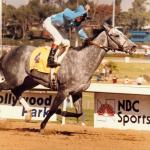
Golden Tempo Goes Last-to-First to Capture Lecomte Stakes at Fair Grounds

In the long and proud history of Thoroughbred racing, there has been a lengthy list of stables that dominated their era and produced a string of great champions.
Somewhere near the top of that list belongs Belair Stud.
Belair’s association with the breed dates back to 1747 when the first Thoroughbreds shipped from England to America were stabled at the Collington, Md., farm.
Belair horses were involved in the colonies’ early races in the 1750s, but the farm’s glory days came in the 20th century when the Woodward family turned Belair into one of the nation’s preeminent racing and breeding operations.
Under the leadership of owner William Woodward Sr., Belair dominated Thoroughbred racing for more than 20 years. Chairman of The Jockey Club from 1930 to 1950, Woodward built a stable that prospered in the 1930’s through the 1950’s as it produced many of the sport’s greatest champions and many of the era’s major races.
Of the 12 Triple Crown winners, two of the first three raced in Belair’s famed white silks with red polka dots.
The homebred Gallant Fox was the first of them, sweeping the Kentucky Derby, Preakness and Belmont Stakes in 1930.
A cornerstone in Belair’s growth was Woodward’s decision to partner with A.B. Hancock, Sr. and several other men to purchase the English sire Sir Gallahad III for a price tag of $125,000, which was outlandish for the time, and bring him to the United States.
Gallant Fox, a son of Sir Gallahad III, helped to make it a wise investment as he won 11 of 17 races in his career for Belair and legendary trainer “Sunny” Jim Fitzsimmons. In 1930 he was named the champion 3-year-old after becoming the first horse to earn more than $300,000 in a year. He was inducted into the National Museum of Racing and Hall of Fame in 1957.
Aside from the Triple Crown races, Gallant Fox also won the Jockey Club Gold Cup, Lawrence Realization, Saratoga Cup, Dwyer and Wood Memorial.
As great a runner as Gallant Fox was, he was an equally successful sire.
In 1935, Gallant Fox’s son Omaha gave Belair its second Triple Crown winner and a runner who earned more than $150,000 in his career and was inducted into the Hall of Fame in 1965.
Gallant Fox also produced Granville, who carried Belair’s silks victory in 8 of 18 races and numbered the Belmont, Travers, and Lawrence Realization among his 1936 wins.
Granville also defeated Discovery by eight lengths in a match race in the 1936 Saratoga Cup and at year’s end was voted the sport’s first Horse of the Year. He entered the Hall of Fame in 1997.
Sir Gallahad III proved to be an outstanding sire, earning acclaim as the nation’s champion sire four times and turning out talented runners for Belair like Vagrancy, the champion older female of 1942.
Belair’s best horses also included Johnstown, a 1992 Hall of Famer who won the 1939 Kentucky Derby and Belmont Stakes and missed out on a Triple Crown sweep when he finished fifth on a muddy track in the Preakness, and 1932 Belmont Stakes winner Faireno.
Woodward passed away in 1953 and his son William Woodward Jr. assumed control of the stable, which had one more grand moment of glory ahead of it.
Though he did not sweep the Triple Crown, Nashua may have been Belair’s most brilliant runner. He was a champion at 2, winning the 1954 Hopeful and Belmont Futurity in a campaign that featured six wins out of eight starts.
At 3, Nashua cemented a spot in the Hall of Fame and became one of the sport’s most famous champions when he engaged in a classic rivalry with Swaps.
The California-based Swaps beat Nashua in the 1955 Kentucky Derby and then skipped the next two legs of the series as Nashua took the Preakness by a length and the Belmont by 9 lengths.
The two met again later that year in a famed match race that was held at Washington Park on Aug. 31. Swaps was favored, but Nashua was a decisive winner, pulling away to record a 6 ½-length victory under jockey Eddie Arcaro.
Nashua, a 1965 Hall of Fame inductee, closed the year with a five-length victory in the Jockey Club Gold Cup and was named both Horse of the Year as well as the champion 3-year-old male of 1955.
The joy that Nashua brought to the Woodward family and Belair, however, was shattered on the night of Oct. 31, 1955 when Woodward Jr. was shot and killed at his home by his wife, who mistakenly believed he was an intruder.
Following Woodward’s death, his Thoroughbred holdings were sold, ending Belair’s long run as one of the sport’s most successful breeding and racing operations.
In the end, Belair was represented by five horses that were voted into the Hall of Fame. Among its more than 630 all-time wins, Belair owned three victories in the Kentucky Derby, three in the Preakness, six in the Belmont Stakes and left behind a legacy of greatness that still resonates nearly 60 years after its final race.
Fun Facts
|